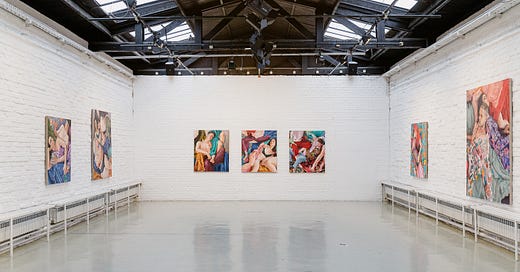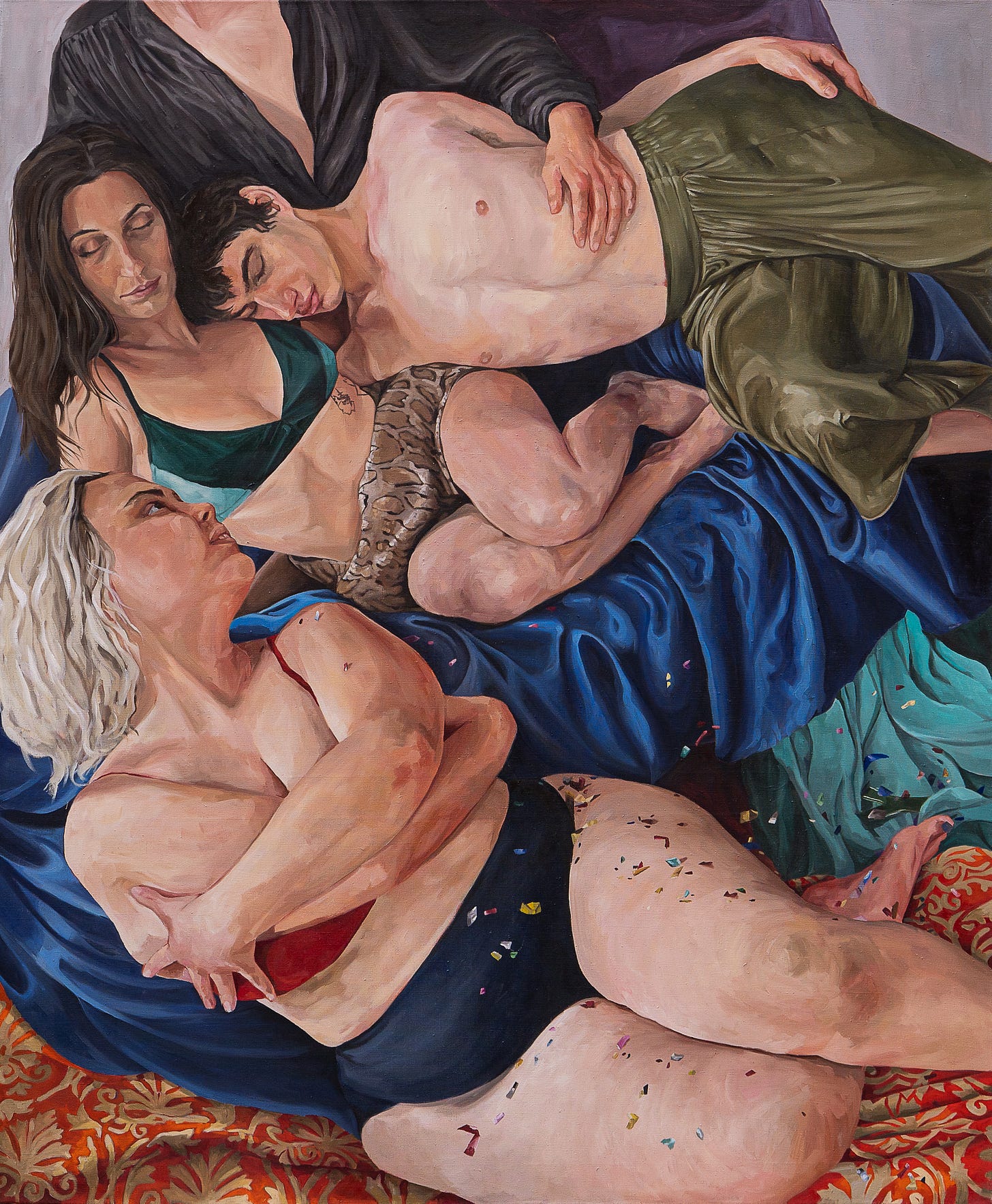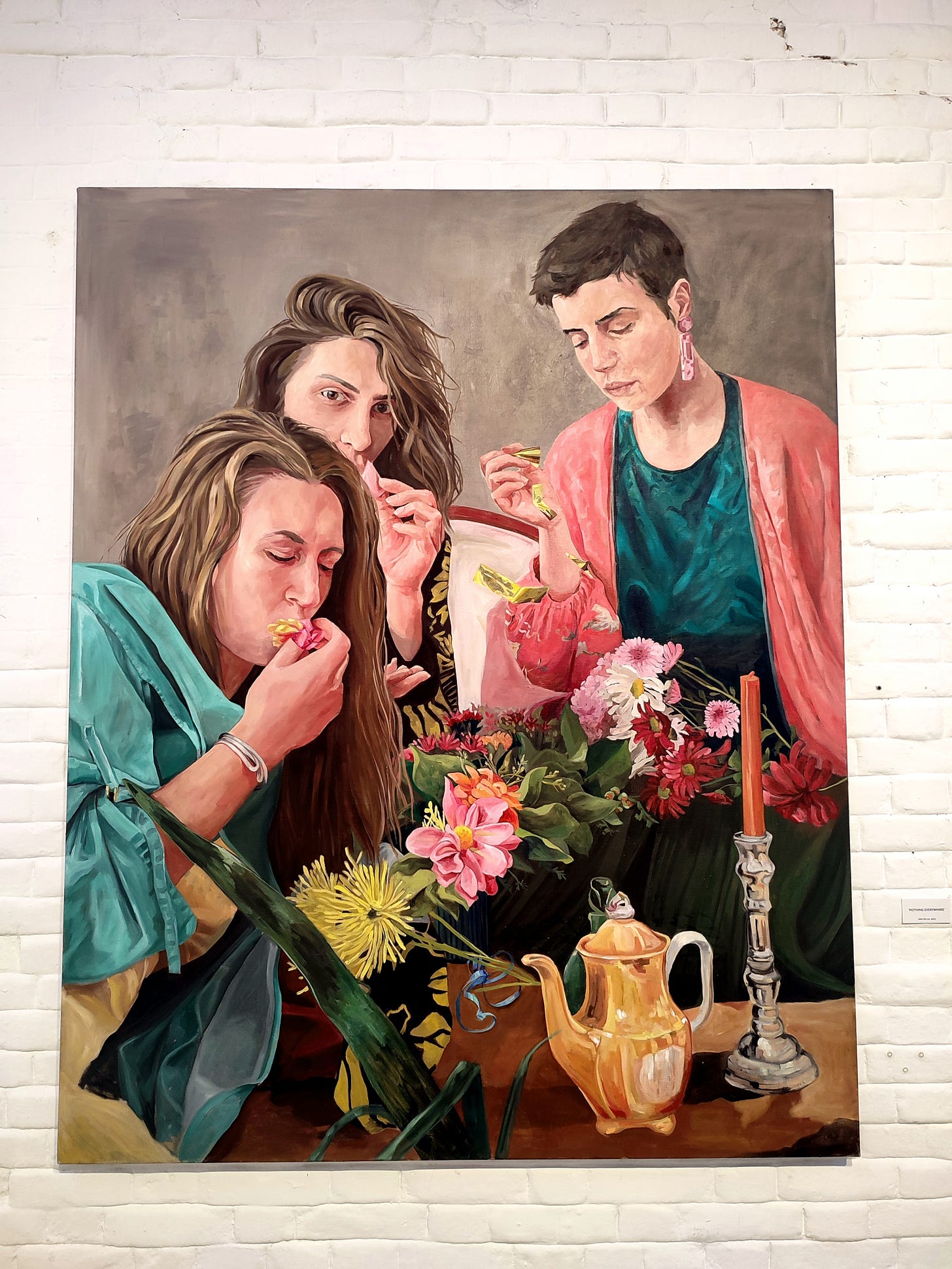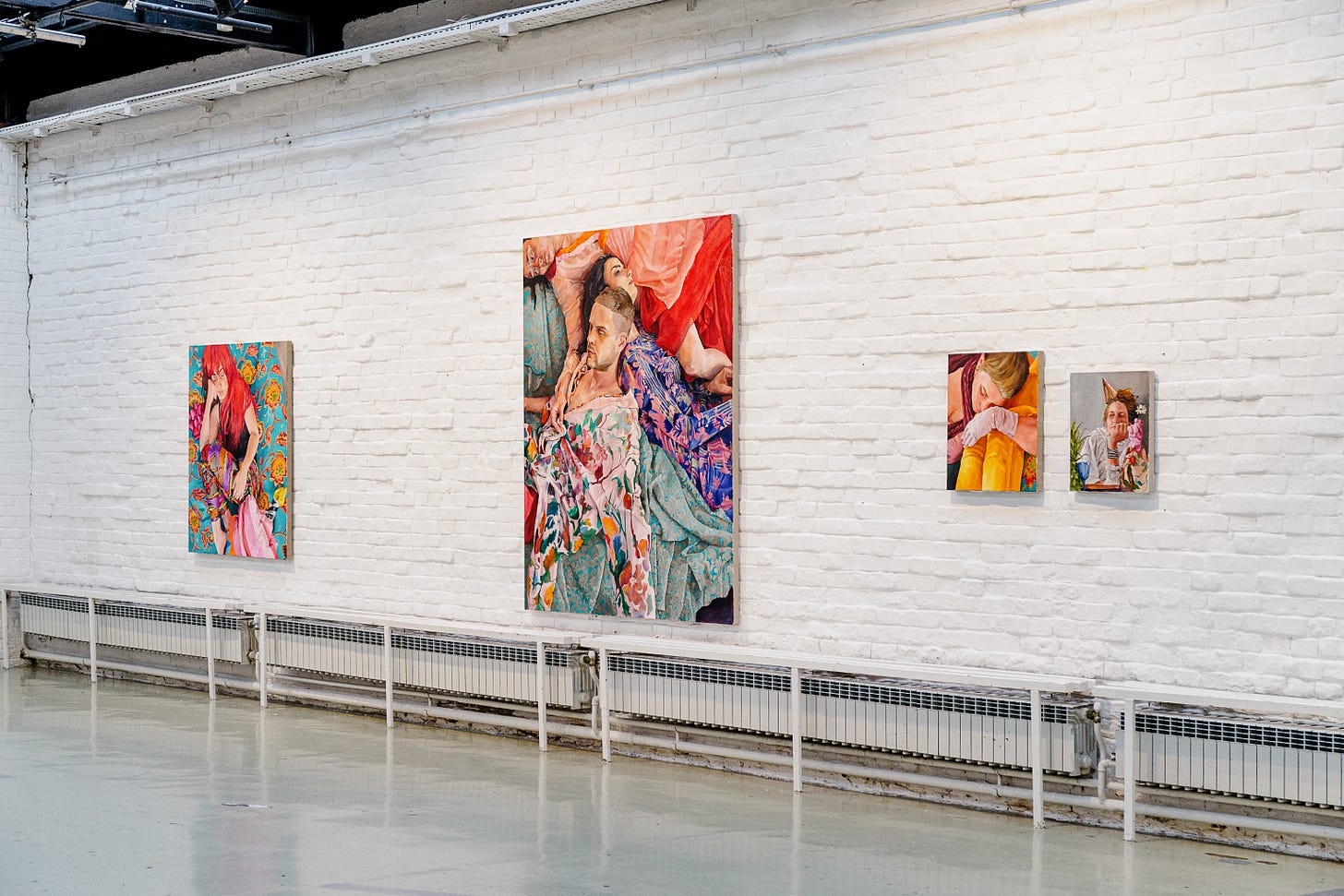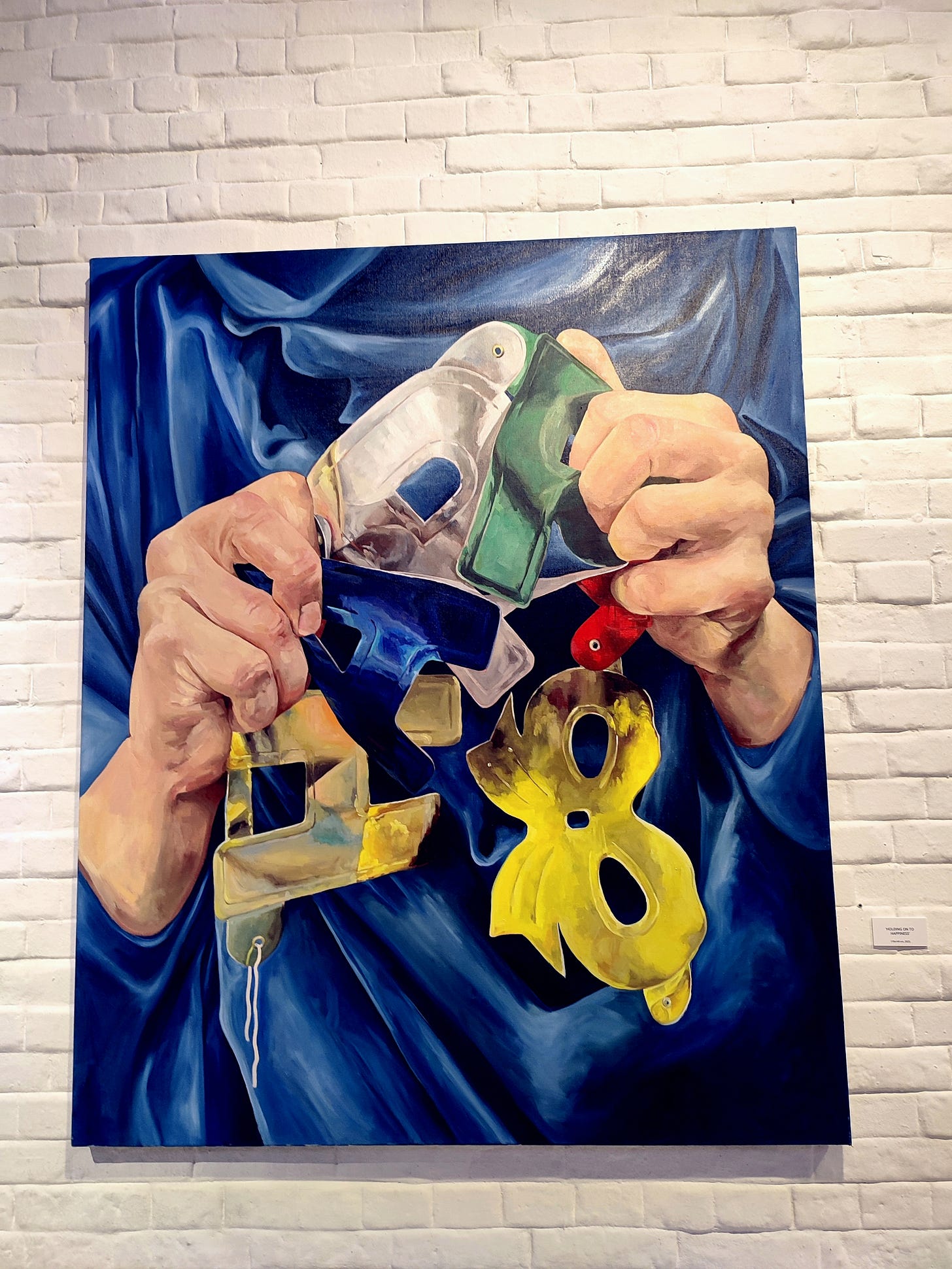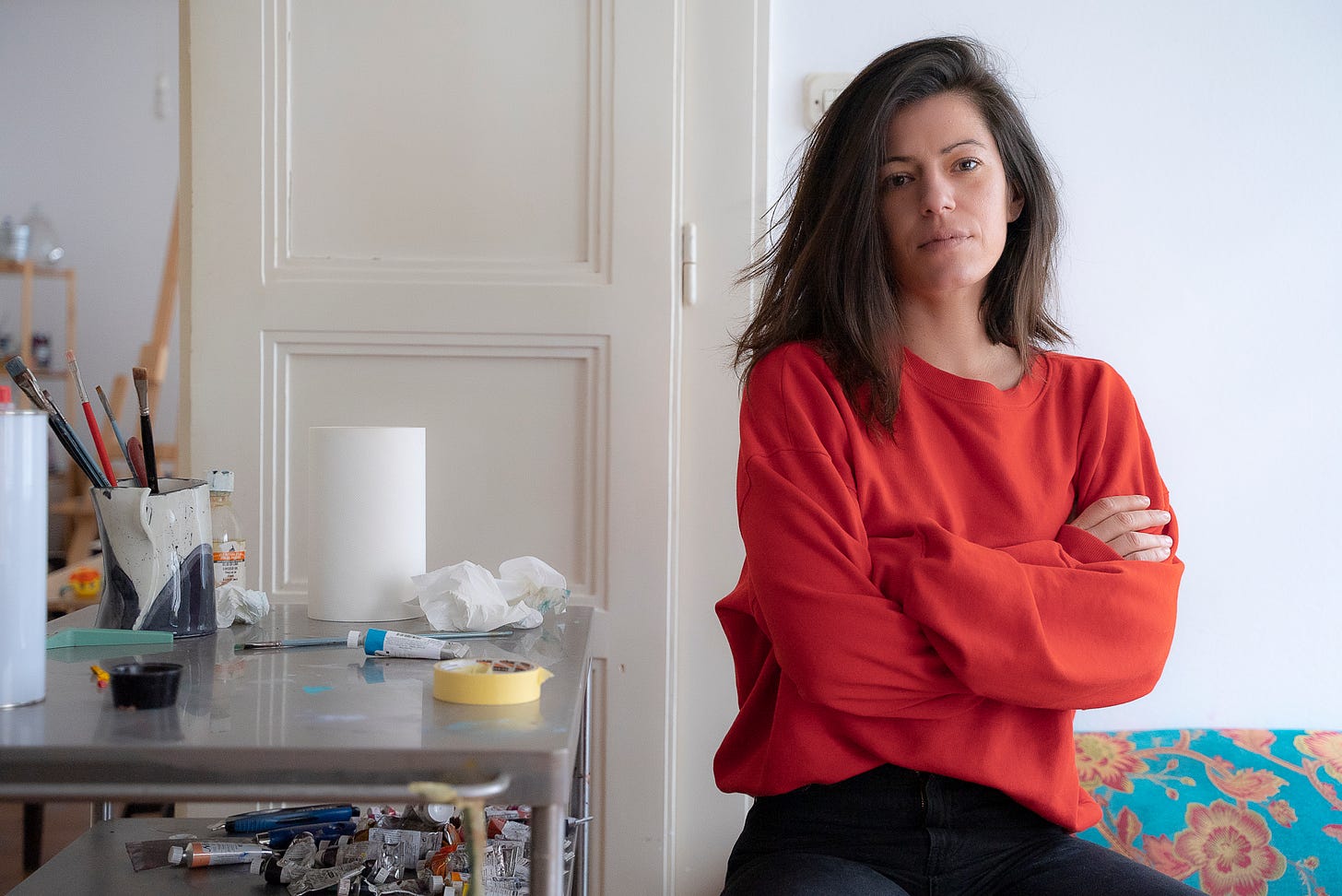Living the Afterparty
A conversation with Tarantula: Authors And Art's Inspiration for July, Maša Barišić
I stumbled across an invitation to the opening of Maša Barišić's exhibition “Dark Euphoria /The Afterparty” at the SC Gallery in Zagreb while scrolling through events on Facebook. My eyes were drawn to a picture with extremely vivid colors and a seductive melancholy emanating from it. I clicked on the "Interested" option and started planning how to squeeze in a visit to the opening of the exhibition that Friday considering we already had planned dinner with some friends. As fate would have it, the very following day, that same friend contacted me with the suggestion that we go to the opening of Maša Barišić's exhibition before our dinner. My friend turned out to be a dear friend of Maša whose drawing classes she had once attended. I immediately opened the Facebook invitation and changed my status from "Interested" to "Coming".
The exhibition begins with a small painting of the close-up on the mouth full of rose petals, devouring aromatic flowers and their juices as if they want to suck up all the sweetness of this world, and ends with a large painting of a close-up of hands tightly clutching the party sign “HAPPINESS”. Between these two motifs, on the large white walls of the SC gallery, there are paintings of great and small dimensions on which, just like cats, attractive young people are lying around lazily. Their faces and bodies are sensual, alive, as if they were paused just a second ago.
I felt like I was stepping into one of those mystical parties reserved for the selected few, which are whispered about but never attended, and to which you cannot get an invitation but can only be introduced by a well-verified insider. However, it felt like I arrived at the after-party, the party had already passed its peak, and the beautiful party-goers had already stretched out tiredly on the divans, the make-up had been smeared, and the shiny dresses and suits had been replaced by silk kimonos and velvet pajamas... there was only enough energy left for one more selfie.
Maša Barišić spent her early childhood on the Croatian island of Hvar, and grew up in London, where she graduated from an art academy. Today she lives and works in Zagreb. Reading the various interviews with Maša on different art and lifestyle portals, I found out that Maša only wears black clothes even though she likes colors, that she believes that art does not have to be activist, because even intimate questions give important social answers, that for her, painting is "the language she speaks."
Still, there were more I wanted to find out, so I have reached out to Maša to interview her for Tarantula: Authors and Art.
This May you presented your work in two exhibitions, a group exhibition “The Visible Ones” and your own independent exhibition „Dark Euphoria/The Afterparty.“ The exhibition “The Visible Ones” represented more than eighty female authors and highlighted the noticeably low representation of women artists in galleries and museums. Thought history women were visible in art mostly just as an object or an inspiration, not as authors and artists. How do you see women in fine art today?
I see this changing and I see more women as authors in fine art today especially in America and the rest of Europe, slowly this is catching up in Croatia too. The visibility of women in art is something the world is talking about and I think it’s a good conversation to be having. I think diversity is good for art and fine art today is perhaps the most open it has ever been to artists of all gender, color, and ethnic backgrounds.
Is there a notion of “women's fine-art“ as there is “women's writing” and if there is, what connotation does it bring?
I don’t think art should be divided into male and female art, but there are male and female artists, and sometimes gender is relevant to the context of the artist's work.
Your latest individual exhibition “Dark Euphoria/The Afterparty" displayed paintings described as „a portrait of a dystopian generation.“ Do you agree with that statement or is it more intimate?
I believe that I am a part of this generation, the narrative that we are living is dystopian, and it infiltrates our private lives. Some of the paintings are intimate and some less, but they are all about the dystopia that we are living through, how what we consume in the media and social networks distorts our reality, and what we think influences how we feel so I would not keep these things very separate as feelings are ultimately intimate.
Do you find any similarities with the “Lost Generation” from the period of the 20s of the last century that was described as "disoriented, wandering, directionless" in novels and poems by Hemingway, F. Scott Fitzgerald, Gertrude Stern…
We have the internet, which has made everything possible, and that is an impossible concept to grasp, just like the American Dream. The resemblance of generations is similar in the way they reject the traditions and norms of the old generations, which is perhaps true for every new generation. Big changes are happening in our lives and we are trying to catch up but the difference between these generations is the capillary production of spectacle which is much more aggressive in our time. The idea of the public and private is also a big question, so I see the resemblance and I do think that the feeling of dystopia is a part of a cycle.
The title „Dark Euphoria“ is borrowed from the writer Bruce Sterling, but you added “The Afterparty.” Why do we need the afterparty, in life as well as in the title of your exhibition?
I don’t think we need the afterparty, but I do believe we are at a time in history that resembles an afterparty. Changes are happening fast probably faster than ever before in history, with the internet and all the new technology we are trying to keep up and I am not so sure we are doing a good job. We are living a life filled with uncertainty, idleness, and the illusions of accessibility. It is an unusual blend of intrusiveness and fragility, ambition and passivity.
You mentioned that the series is autobiographical. Is your art always autobiographical?
I think all art is, it can not be dissociated from the person who makes it even if it is unconscious. As authors, we put ourselves in the work as it is our voice, our beliefs and our aesthetics.
It takes time to produce such a big number of paintings, how does time affect your relationship with the theme, techniques… do you have a plan for the series, predetermined motives you want to paint or does the series develop Intuitively...
The challenge is to keep working, even if you are not getting anywhere. The process has highs and lows, sometimes you are at the top of the world and sometimes none of it makes sense but you keep working. I love the act of painting, it grounds me and it is the closest I have come to meditating in my life, but it is not always easy and it takes up a lot of time. The way I paint is very time-consuming and sometimes I will paint the same painting for three months. This makes it even harder since I am looking at the same image every day for three months. I have plans before I start painting, but they are not set in stone, so the creative process changes the plans often. I have been preparing for two to three years for this exhibition.
Tell as a bit more about your creative process. Do you use photography or live model pose? Do you start with decision to focus on colors, corporeality, textures..
I use live models which I then photograph, I have some compositions in my head that I start with, but a lot of it is done by experimenting during the photoshoot and later when I start painting. I rely on intuition a lot and I leave room in the process for accidents to happen.
In this series, paintings in different formats, big and small, are often connected; motives re-appear from one painting to another. Painting titles add additional levels of meaning and narrative. Going thought the exhibition it feels like watching a movie or browsing the internet thought a series of hyperlinks. I felt that you want to direct, manage the viewer's attention, direct to a certain detail, moment, guide them… Do you feel the need to converse with the audience thought your work. Do you feel the need to direct them?
As a painter, I communicate visually and a little with words. Of course, once the painting is exhibited, it is no longer my responsibility to tell the viewer what to take from it. My job is done once the painting leaves the studio, and everything else afterward is out of my hands (apart from the interviews.)
Do you feel reluctant to give up control once the art is published/presented to the public?
No, in a way it’s freeing to let it do what it will do.
Artists were often public figures, celebrities. How do you feel towards media attention, PR obligations, interviews… How important is self-promotion for an artist today? Do you think it is necessary for an artist to have her/his own social media and be active in the media and public?
I feel it is very important to be present in the media today, especially because there is no real art criticism. Previously, there was a system of plus or minus (good or bad), but today it’s zeros and ones (visible or not visible). We are living Guy Debord’s prophecy, “What is good is visible, visible is what is good”. At the same time, I don’t think it’s a natural habitat for most artists to be so exposed to media because what we do is very lonely and solitary; we are alone in the studio for very long periods, so it’s a bit of a contradiction to be “public”.
In one interview you stated that “Art labor is not a choice, but a lifestyle, and going to the atelier is a job just as any other job.” Do you believe that the notion of an artist as someone who works to express inner inspiration, for primary, the personal need to create art, is romanticized?
Going to the studio and working hours is just like any other job, as I found out that I need working hours to help keep my discipline. What makes it perhaps different from any other job is that it is never finished, and you carry it with you everywhere you go at all times. It turns into an obsession, and there is nothing romantic about it until there is.
Do you consider how they will be presented at the art gallery and the buyer's house as you work?
Never. If I have a gallery that I am working for I will have some idea about the formats and the number of paintings I need, but that is all.
In interviews, you often describe your painting process as "unraveling riddles", "solving problems", "meditation and therapy", but also "the language I speak", storytelling in one frame", tell us more about your personal relationship with the production process and how it affects you as an artist?
The process is the reason I paint, it's where the “magic” happens and sometimes it feels like agony. It’s a process of discovery and not only about the painting but about yourself too. Sometimes I don’t feel like I have much control over it ,but “IT” has more control over me as it is impossible to quit, yet once the painting is finished there is some gratification.
To find our more about Maša Barišić, you can visit her Instagram page masabarisic

